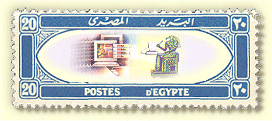PRESENT: Nine members were present; apologies for absence were received from eight members.
The Chairman, Peter Andrews, welcomed those in attendance, while regretting that the inclement weather had kept numbers down - "small but select" - and wished all members, whether present or not, a Happy New Year and good luck with their collecting in 2009. He was sad to have to announce that our New Zealand colleagues had been forced to cancel, though lack of interest, the international get-together planned for February, and appealed to members to join in the next time another of the always-delightful events was to be planned.
Ted Fraser-Smith (ESC 238) reported on recent co-operation with the Civil Censorship Study Group, which has requested a copy of Peter Andrews' monograph Censorship of Civil Mail in Egypt 1939 to 1945 and has apparently been doing parallel work, of which the Library, it is hoped, will soon see the outcome.
The Secretary reported with sadness that Dr Sherif Samra (ESC 311), President of the Philatelic Society of Egypt, had decided to stand down in mid-term as of January 1, and regretted the loss of an excellent colleague who had helped the Circle enormously in recent years. For the time being the Vice-President, Dr Sherif el-Far, will be Acting President until the next Board elections in Cairo.
Members considering an overnight stay in York for the meeting on July 18 organised by Keith Pogson (ESC 130) at York Racecourse stamp fair can receive details of accommodation from the Secretary, who also gave details of an ABPS seminar on one-frame exhibitions on February 28. The meeting decided to advertise in the handbook of the Centenary Congress of GB, to be held on Manchester on July 16-19.
Mike Murphy then thanked those members who had criticised his attempt to classify the Rural postmarks and appealed to members to provide illustrations of their Rural covers so that a forthcoming handbook can be as comprehensive as possible.
As several officers were unavoidably absent, reports were limited to Edmund Hall's announcement that thanks to his recent appeal members had been generous in providing enough new articles to complete the forthcoming Spring QC; but that the long-term outlook was still far from rosy. Please, all members, put pen to paper (or finger to keyboard, whichever suits) to entertain, educate - or question - your colleagues!
Peter Andrews then continued his meeting on postal stationery, which was not completed in November. He started with the Air Letters, showing the whole range from 1944 to the last, issued in about 1983 with an "Air Mail" boxed handstamp on the 1969 Registered Letter Sheet. He noted that he had never seen this latter used, nor the Arab League 30m issue of 1970 uprated and mint. It is possible that the PO never issued it uprated but that extra stamps were added as required for service to non-Arab countries.
There then followed an exhaustive display of envelopes, both mint and used, from the very first in 1887, with a 1-piastre rate, through an astonishing variety of variants. As an example, watermarks ranged from none to Postes Egyptiennes to Egyptian Postage to Bareed al-Masry in two forms, then the Royal Crown and F and finally the Large Eagles. Variants in wove or laid paper, the size and shape of the flap, of the size and configuration of surcharges, of the screen used on the value vignette, of the inner filigree design of the envelope - the range was staggering and apparently complete. And all of that is in addition to varieties of envelope size, of stamp design and alterations in stamp design. No wonder it was necessary to take two meetings to cover such an enormous range of collecting.
Despite all that, the questions came from all sides of the floor - and though most of them were swiftly answered, it is clear that there is more research to be done here: an ideal area for an enthusiast wondering what to do next? After all that, it was a blessed relief to move on to the comparatively calm waters of the cassette envelopes.... until it became apparent that even these recent additions to the postal stationery catalogue present a number of varieties and problems clearly not yet comprehensively explored.
Members thanked Peter, in the traditional manner, for a fascinating display. And wished him well in trying to work his way through the myriad areas of new work brought to light by his exposition over two afternoons.
|

